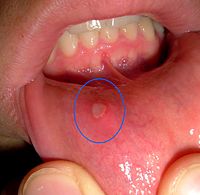
Photo from wikipedia
The aim of this study was to examine how the composition and properties of saliva change in people with osteoporosis who have received antiresorptive (AR) treatment, compared to patients with… Click to show full abstract
The aim of this study was to examine how the composition and properties of saliva change in people with osteoporosis who have received antiresorptive (AR) treatment, compared to patients with osteoporosis who have not yet received this treatment. Methods: The study population consisted of 38 patients with osteoporosis using AR drugs (Group I) and 16 patients with osteoporosis who had never used AR drugs (Group II). The control group consisted of 32 people without osteoporosis. Laboratory tests included determination of pH and concentrations of Ca, PO4, total protein, lactoferrin, lysozyme, sIgA, IgA, cortisol, neopterin, activity of amylase at rest, and stimulated saliva. The buffering capacity of stimulated saliva was also determined. Results: There were no statistically significant differences between the saliva of Group I and Group II. No statistically significant correlation was found between the amount of time using AR therapy (Group I) and the tested parameters of the saliva. Significant differences were found between Group I and the control group. The concentrations of PO4, lysozyme, and cortisol were higher, while concentrations of Ca ions, sIgA, and neopterin were lower, in comparison to the control group. The significant differences between Group II and the control group were smaller, and they concerned only the concentrations of lysozyme, cortisol, and neopterin. Conclusions: The saliva of people with osteoporosis subjected to AR therapy and those not subjected to AR therapy did not show statistically significant differences in terms of the examined parameters of the saliva. However, the saliva of patients with osteoporosis taking and not taking AR drugs was significantly different compared to the saliva of the control group.
Journal Title: International Journal of Environmental Research and Public Health
Year Published: 2023
Link to full text (if available)
Share on Social Media: Sign Up to like & get
recommendations!